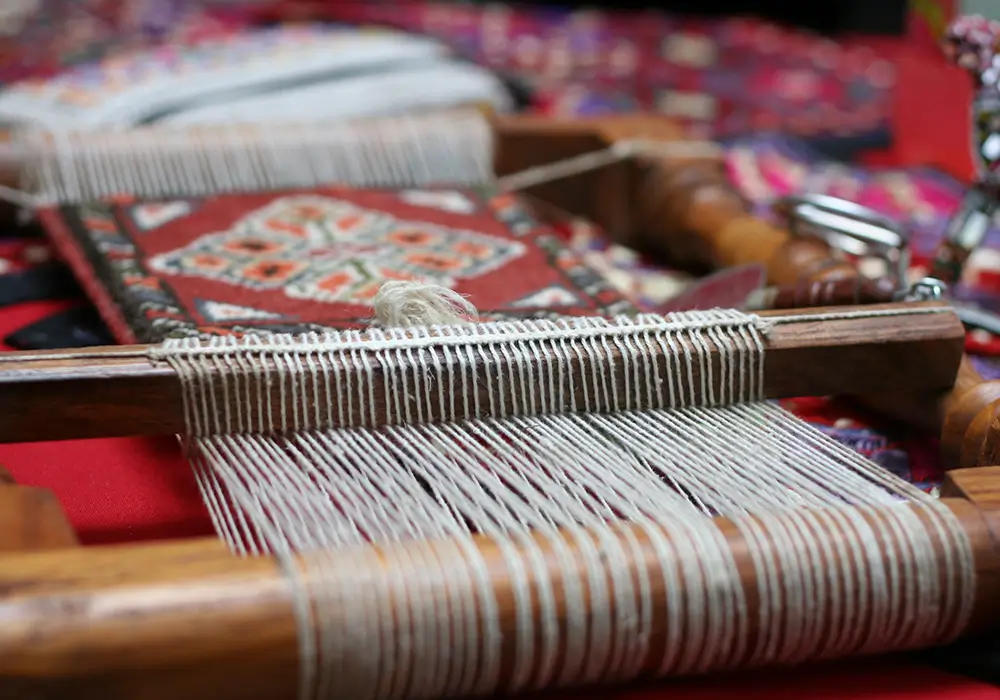One shuttle weave
- Copy
The timeless art of weaving holds a special place in India’s heritage. Tracing its origins back to the Indus Valley civilisation, this treasured artform not only reflects the richness of our cultural heritage, but also serves as a powerful symbol of women’s empowerment, given that over 70% of workers in this sector are women. Though custodians of this glorious tradition, India’s weaving communities have faced an array of challenges over the years.
Back to front

Until the 17th century, India was responsible for a quarter of the global textile production. But shortly after the British colonised the country, the weaving community began facing a multitude of challenges – starting with the introduction of industrial looms.
However, undeterred by adversity, Indian artisans successfully overcame these challenges and managed to hold on to their craft. In fact, the humble spinning wheel even became a symbol of self-reliance or ‘swadeshi’ during the nation’s storied struggle for independence.
Years passed by but a grouse that many weavers faced was the poor quality of yarn, which often broke and entangled, causing frequent interruptions to their craft.
It was 2015, when a beacon of hope emerged. Birla Cellulose introduced Liva to the market, promising to put an end to the weavers’ woes. As a sustainable and affordable fibre crafted from wood pulp, Liva became a game-changer in the textile industry, lending a soft, silky feel and fluid look to apparel. Unlike cotton, wood pulp offers far greater stability as the trees are specifically grown for this purpose.
Overcoming initial scepticism, weavers soon discovered the numerous benefits Liva offers over conventional fabrics. One notable advantage is that Liva fibres do not break like the traditional fibres they used before. It made business sense to adopt the new fabric. Today, Liva is tagged on 7.8 million garments.
To help the community become future-ready, Birla Cellulose conducted several seminars teaching them not just about yarns and fibre but also about entrepreneurship. To date, it has trained over 1,500 artisans across seven Indian states.
Watch the film ‘Six Yards, a LIVA story’ to learn about the transformative impact of Liva on the lives and livelihoods of Indian weavers.
Another hurdle to cross
The Covid-19 pandemic and the subsequent lockdowns cast a shadow of economic uncertainty over every industry – and the handloom sector was no exception. Overnight, several orders came to a grinding halt, leaving countless weavers grappling with the sudden loss of their sole livelihood.

With little hope, many of these weavers, particularly among the younger generation, were confronted with the difficult decision of abandoning their ancestral trade in search of alternative sources of income. But if this were to unfold, the repercussions would be far-reaching, not to mention irreversible. If this tradition skips even a single generation, it runs the risk of becoming extinct. It was at this dire junction that Aadyam Handwoven, a corporate social initiative by Aditya Birla Group, rekindled the lost enthusiasm among weavers. Aadyam Handwoven has been working with weaver communities in India for many years with a vision to create a self-sustaining ecosystem for the finest artisans of the country and make their handicrafts accessible to a global audience.
Aadyam Handwoven works closely with three weaving communities in India – in Bhuj, Varanasi, and Pochampally – each known for its distinct weaving style. Amid the throes of the pandemic, Aadyam Handwoven stepped in to support weavers by placing orders and providing them with much-needed business development assistance. This not only bolstered their confidence, but also scaled their business further and helped them sustain during these challenging times.
Among the many beneficiaries of this initiative is 25-year-old Sunil Kumar Maurya from Varanasi. His family had been engaged in the art of Tachnoi hand-weaving, but since his father’s demise, he found it extremely difficult to single-handedly continue the business. Coupled with the onslaught of the pandemic, his workers also left him in search of other opportunities. But with the support of Aadyam, Sunil was able to win back his workers and expand his operations to 11 looms.
These are some of the many stories where the Group has stood by the traditional artforms. Aditya Birla Group salutes the invaluable contributions of weavers across our country who are tirelessly working to preserve our age-old weaving traditions.

















